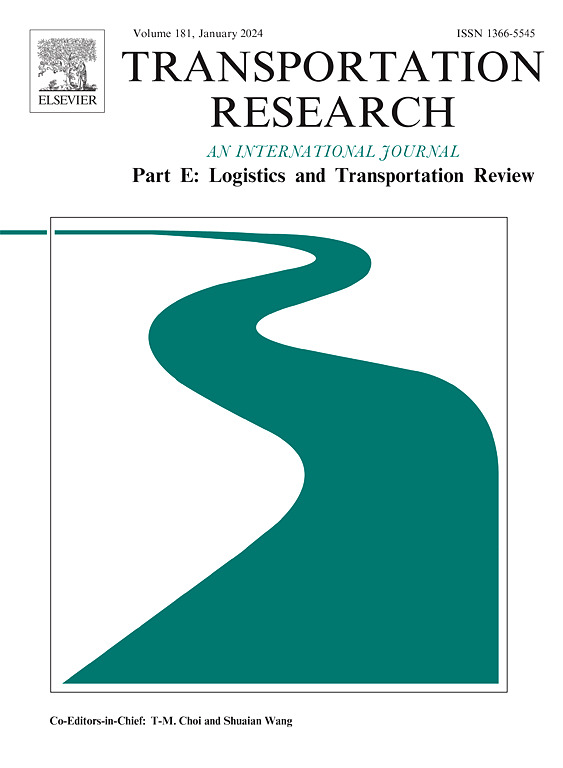Cargo selection, route planning, and speed optimization in tramp shipping under carbon intensity indicator (CII) regulations
IF 8.3
1区 工程技术
Q1 ECONOMICS
Transportation Research Part E-Logistics and Transportation Review
Pub Date : 2025-02-01
DOI:10.1016/j.tre.2024.103948
引用次数: 0
Abstract
To mitigate the significant environmental impacts of the shipping industry, the International Maritime Organization (IMO) introduced the Carbon Intensity Indicator (CII), which measures CO2 emissions per unit of cargo-carrying capacity and distance traveled. While the implementation of energy-efficient technologies is crucial for meeting CII regulations, these advancements often entail substantial investment costs. Consequently, optimizing operations has become a more practical short-term approach; however, operational adjustments made solely to comply with CII regulations may also have unintended adverse effects. To address this issue, this research develops a pick up and delivery optimization model for tramp ships, which operate on irregular schedules and routes, to minimize total emissions and costs while complying with CII regulations. The model investigates the combination of cargo selection, route planning, and speed optimization, reflecting the comprehensive and unique characteristics of tramp shipping. The problem is solved using Danzig-Wolfe decomposition and a branch-and-price algorithm, with the CII regulations being met in the pricing problem through a customized heuristic. Numerical results demonstrate that the proposed approach can find optimal or near-optimal solutions within a short time. Various experiments explore the effects of CII regulations on tramp shipping operations, environmental performances, and economic benefits. The results indicate that demand-based CII and stricter CII regulations cause ships to carry fewer cargoes, sail shorter ballast distances, reduce speed, and increase load on board. This ultimately reduces CO2 emissions but also lowers total profits. The findings assist industry stakeholders in complying with stringent environmental regulations and aid policymakers in designing targeted regulatory policies, thereby promoting sustainable maritime transport.
碳强度指标(CII)规定下不定期航运的货物选择、路线规划和航速优化
为了减轻航运业对环境的重大影响,国际海事组织(IMO)引入了碳强度指标(CII),该指标衡量单位货物运载能力和行驶距离的二氧化碳排放量。虽然节能技术的实施对于满足CII法规至关重要,但这些进步往往需要大量的投资成本。因此,优化操作已成为更实用的短期方法;但是,仅为遵守CII规定而进行的操作调整也可能产生意想不到的不利影响。为了解决这一问题,本研究开发了一种针对不定期船舶的提货和交付优化模型,以最大限度地减少总排放量和成本,同时符合CII法规。该模型将货物选择、航线规划和航速优化结合起来进行研究,反映了不定期航运的综合性和独特性。采用danzigg - wolfe分解和分支定价算法求解该问题,并通过自定义启发式算法满足CII规则在定价问题中的要求。数值结果表明,该方法能在短时间内找到最优或近最优解。各种实验探讨了CII法规对不定期航运业务、环境绩效和经济效益的影响。结果表明,以需求为基础的CII和更严格的CII法规导致船舶载货量减少,航行压舱距离缩短,速度降低,船上负载增加。这最终减少了二氧化碳的排放,但也降低了总利润。研究结果有助于行业利益相关者遵守严格的环境法规,并帮助决策者设计有针对性的监管政策,从而促进可持续的海上运输。
本文章由计算机程序翻译,如有差异,请以英文原文为准。
求助全文
约1分钟内获得全文
求助全文
来源期刊
CiteScore
16.20
自引率
16.00%
发文量
285
审稿时长
62 days
期刊介绍:
Transportation Research Part E: Logistics and Transportation Review is a reputable journal that publishes high-quality articles covering a wide range of topics in the field of logistics and transportation research. The journal welcomes submissions on various subjects, including transport economics, transport infrastructure and investment appraisal, evaluation of public policies related to transportation, empirical and analytical studies of logistics management practices and performance, logistics and operations models, and logistics and supply chain management.
Part E aims to provide informative and well-researched articles that contribute to the understanding and advancement of the field. The content of the journal is complementary to other prestigious journals in transportation research, such as Transportation Research Part A: Policy and Practice, Part B: Methodological, Part C: Emerging Technologies, Part D: Transport and Environment, and Part F: Traffic Psychology and Behaviour. Together, these journals form a comprehensive and cohesive reference for current research in transportation science.

 求助内容:
求助内容: 应助结果提醒方式:
应助结果提醒方式:


